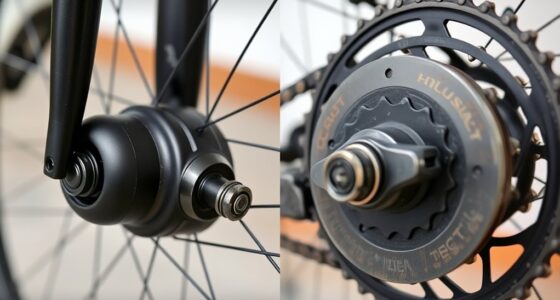When maintaining chain versus belt drives, you should regularly lubricate chains to reduce wear and check tension with tools like gauges or simple deflection tests. Belt drives need tension adjustments through pulley repositioning and generally require less maintenance, as they’re less exposed to dirt. Both systems benefit from proper tools and scheduled checks to prevent slippage and damage. If you stay consistent with maintenance, you’ll keep your drive system running smoothly—more tips coming up if you continue to explore.
Key Takeaways
- Chain drives require regular lubrication and tension checks, especially in dusty or wet environments, using specific tools like tension gauges.
- Belt drives mainly need tension adjustments through tensioner pulleys, with less frequent maintenance due to lower contamination exposure.
- Chains demand more frequent maintenance due to dirt and moisture, utilizing lubricants and tension tools for optimal performance.
- Belts benefit from simple tension checks and adjustments, often using deflection tests or tensioner repositioning, with minimal lubrication.
- Proper maintenance tools, such as tension gauges and adjustable tensioners, are essential for both systems to ensure longevity and efficiency.

Have you ever wondered which drive system is better for your machinery—chain or belt? When it comes to maintenance schedules and tools, understanding the differences can save you time and prevent costly breakdowns. Both systems require specific care, but the key factors are lubrication frequency and tension adjustment. These elements guarantee peak performance and longevity of your drive components.
If you choose a chain drive, you’ll need to pay close attention to lubrication. Chains are exposed to dirt, dust, and friction, which can cause wear if not properly lubricated. Regular lubrication minimizes metal-to-metal contact, reducing wear and extending the chain’s life. The lubrication frequency depends on your operating environment—more frequent in dusty or wet conditions. Using appropriate lubricants, like chain oil or spray lubricants, helps maintain smooth operation. Alongside lubrication, tension adjustment is vital. You must regularly check and adjust chain tension to prevent slippage or excessive wear. Too tight, and you risk stressing the sprockets and bearings; too loose, and the chain may jump or slip. Tension adjustment tools, such as a tension gauge or a simple ruler, help you set the correct tension. Many systems feature an adjustable tensioner or link, simplifying this process. Additionally, using specialized maintenance tools designed for chain systems can further optimize tension and lubrication procedures.
Belt drives, on the other hand, generally require less frequent lubrication, as most belts are constructed from materials that don’t need regular oiling. Instead, the focus shifts to maintaining proper tension. Over time, belts can stretch, causing slippage or reduced efficiency. Regular tension checks—using a tension meter or a simple deflection test—are essential. Adjustments are often straightforward, involving loosening a tensioner pulley and repositioning the belt. Unlike chains, belts are not exposed to dirt and debris as much, which makes them cleaner and easier to maintain in dirty environments. However, belt tension is critical; too loose, and the belt slips, reducing power transfer; too tight, and you risk damaging bearings or the belt itself. Proper tension management helps prevent premature wear and maintains optimal performance.
Frequently Asked Questions
How Often Should I Replace a Chain or Belt?
You should replace your chain every 3,000 to 5,000 miles, depending on riding conditions, while belts typically last 30,000 to 50,000 miles. Regularly perform chain lubrication to prevent rust and wear, and check chain tension to avoid slippage. For belts, ensure proper tension adjustment to prolong their lifespan. Keep an eye on signs of wear, like cracks or slack, to know when replacements are needed.
What Tools Are Needed for Routine Maintenance?
You’ll need a chain or belt cleaner, lubricant, and a tension gauge for routine maintenance. Use lubrication techniques to keep your chain or belt smooth, applying oil or spray as per manufacturer instructions, and regularly check tension adjustment to prevent slipping or excessive wear. A tension gauge helps you set the correct tension, ensuring peak performance and longevity. Don’t forget to inspect for wear or damage during each maintenance session.
Can I Switch Between Chain and Belt Drives Easily?
Switching between chain and belt drives is like changing gears in a bike—possible but not always smooth sailing. Drive compatibility is key; not all bikes are designed for both types, leading to conversion challenges. You’ll need to contemplate frame and component compatibility, and often, modifications are necessary. It’s best to consult your bike’s manufacturer or a professional mechanic to avoid turning a simple switch into a complicated puzzle.
What Are Signs of Wear in Chain and Belt Drives?
You’ll notice wear signs in your chain or belt drive through looseness, rust, or cracks. For chains, check lubrication frequency and look for stiff links or corrosion. Belt drives show wear with fraying, cracks, or glazing on the surface. Regular tension adjustment helps prevent excessive wear, and keeping your lubrication up to date guarantees smoother operation. Address these signs promptly to avoid costly repairs and extend your drive’s lifespan.
Are There Specific Lubricants Recommended for Chains?
When it comes to chain lubrication, you should opt for a high-quality, light oil or chain-specific lubricant to guarantee smooth operation. Belt lubrication usually isn’t necessary, but if you notice squeaks or stiffness, a belt-specific lubricant can help. Regularly applying the right lubricants keeps your drives running quietly and efficiently, prolonging their lifespan. Remember, using the proper lubricants for chains and belts is key to maintaining ideal performance.
Conclusion
Ultimately, choosing between chain and belt drive is like picking your trusted partner—each has its strengths and quirks. Regular maintenance keeps them running smoothly, preventing costly surprises. Think of it as tending to a garden; neglecting it leads to chaos, but care guarantees long-lasting performance. So, stay vigilant with your gear, and remember: the right upkeep transforms your drive from a ticking time bomb into a well-oiled machine that’s ready to roll—forever faithful.









